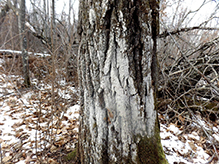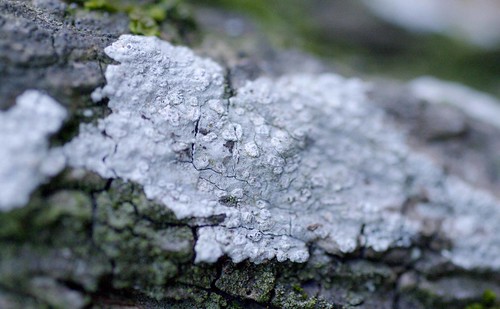Whitewash Lichen
(Phlyctis argena)
Conservation • Description • Ecology • Distribution • Taxonomy
Conservation Status |
|
|||||||
| IUCN Red List | not listed |
|||||||
| NatureServe | not listed |
|||||||
| Minnesota | not listed |
|||||||
Description |
||
Whitewash Lichen is very common in Europe and North America. In the United States it occurs in the Pacific northwest and in the northeast from the East Coast to the Great Lakes region. It grows in very close contact with the substrate (crusticose) on the bark of oak and other deciduous trees, rarely on conifers, and rarely on rock. It neither harms nor benefits the tree. The vegetative body may be thick or thin, small or large. It may appear as a small, well-defined patch with a distinct pale border, or as a large, irregular patch with diffuse pale edges, like a smear of paint. It consists of a central, vegetative portion containing both the algal and fungal partners (thallus), and a border with just the fungal partner (prothallus). The thallus is pale grayish-green or greenish white when fresh. It may be thin and smooth or thick, rough, and cracked. As it ages, the surface becomes gray and/or white, and it develops minute, pale green to bluish-green balls of cells (soredia). The soredia are fine, but they clump together forming coarse granules on the surface. When the thallus is thin the soredia are sparse. When the thallus is thick, the soredia are dense and cover the center. The structures that produce the soredia (soralia) are pale yellow to greenish-white, up to ⅜″in diameter, and usually have a raised rim. As the lichen ages, the soralia erode, leaving just raised lines. The thallus is surrounded by by a white, felt-like, and often conspicuous prothallus. The prothallus often forms a conspicuous white border about ⅜″ wide. Disk-like, spore-producing structures (apothecia) are extremely uncommon. When present, they are minute, 1 ⁄64″ to 3 ⁄64″ (0.2 to 0.4 mm) in diameter, gray to black, and flush with the surface of the thallus, sometimes hidden by it. |
||
Similar Species |
||
Common Button Lichen (Buellia stillingiana) apothecia are very common, more abundant, and larger. |
||
Ecology |
||
Substrate |
||
Trees |
||
Growth Form |
||
Crusticose |
||
Habitat |
||
Bark, rarely rock |
||
Hosts |
||
Oak and other deciduous trees, rarely conifers |
||
Distribution |
||||
|
Sources |
|||
| 1/29/2023 | ||||
Occurrence |
||||
|
||||
Taxonomy |
|||
| Kingdom | Fungi (Fungi) | ||
| Subkingdom | Dikarya | ||
| Phylum | Ascomycota (Sac Fungi) | ||
| Subphylum | Pezizomycotina (Sac Fungi and Lichens) | ||
| Class | Lecanoromycetes (Common Lichens) | ||
| Subclass | Ostropomycetidae (wart lichens, script lichens, and allies) | ||
Order |
Ostropales | ||
Family |
Phlyctidaceae | ||
Genus |
Phlyctis (blemished lichens) | ||
| Mycobiont | Phlyctis argena | ||
| Photobiont | |||
Synonyms |
|||
|
|||
Common Names |
|||
Whitewash Lichen |
|||
Glossary
Apothecium
An open, disk-shaped or cup-shaped, reproductive structure, with spore sacs on the upper surface, that produces spores for the fungal partner of a lichen. Plural: apothecia.
Crusticose
Crusty; referring to lichens in such close contact with the rock surface (substrate) that it appears sprayed on like paint.
Prothallus
The border of a lichen where the fungal partner is growing but the algal partner is not. The color is different than the thallus due the absence of the algae.
Soredium
An asexual reproductive structure of a lichen in the form of a tiny dull granule on the thallus surface that can be easily brushed off. It consists of a cluster of algal cells (the photobiont) wrapped in fungal filaments (the mycobiont), but without an outer layer of protective tissue (cortex). Plural: soredia.
Thallus
The vegetative body of a lichen composed of both the alga and the fungus. Plural: thalli.
Visitor Photos |
|||||
Share your photo of this fungus. |
|||||
| This button not working for you? Simply email us at info@MinnesotaSeasons.com. Attach one or more photos and, if you like, a caption. |
|||||
Luciearl |
|||||
 |
 |
||||
 |
 |
||||
MinnesotaSeasons.com Photos |
|||||
|
|||||

Visitor Videos |
|||
Share your video of this fungus. |
|||
| This button not working for you? Simply email us at info@MinnesotaSeasons.com. Attach a video, a YouTube link, or a cloud storage link. |
|||
Other Videos |
|||


Created: 11/24/2019
Last Updated:




